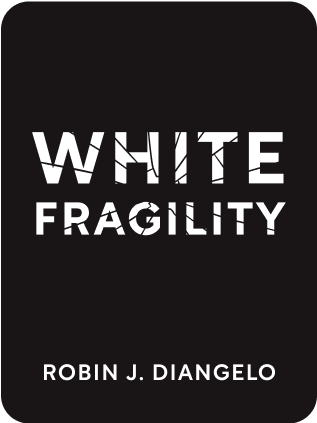

This article is an excerpt from the Shortform summary of "White Fragility" by Robin J. DiAngelo. Shortform has the world's best summaries of books you should be reading.
Like this article? Sign up for a free trial here .
How is white fragility defined? What is white fragility and how is it explained in Robin Diangelo’s book?
White fragility, defined, is about how white people cannot accept their role in systemic racism. So what does white fragility mean for people’s reactions? They become hostile or defensive when confronted by their own racism.
Keep reading for white fragility, defined and illustrated with examples.
What Is White Fragility? Defined by White People’s Reactions
In White Fragility: Why It’s So Hard for White People to Talk About Racism, author and anti-racist educator Robin DiAngelo explores white fragility. What is white fragility? It is the phenomenon by which white people become angry, defensive, or hostile when confronted with the idea that they are complicit in systemic racism. That’s white fragility, defined by the reactions of white people. As a white woman herself, DiAngelo documents the ways in which white Americans are unable to emotionally withstand even minor amounts of racially triggered stress and retreat into a defensive posture when forced to discuss racism.
White Fragility is written for white people who consider themselves to be liberal or progressive on racial matters. Like all white people, white progressives are raised in a society that is institutionally racist. By this, we mean a society in which all key political, economic, social, and cultural institutions are overwhelmingly controlled by white people. This disproportionate share of power is the product of centuries of history during which people of color (especially black people) were systematically enslaved, expropriated, disenfranchised, segregated, and marginalized. As a result, white control of society became the “normal” or “standard” state of affairs.
Being raised in such a society with such a history leaves an indelible mark on white people, even those white progressives who believe they stand in opposition to it. Everyone is socialized by the conditions that surround them—and in the American context, those conditions have always placed white people in a superior position and black and brown people in an inferior position. Simply being white in such a society confers an incalculable advantage.
Misdefining Racism
White progressives, however, believe themselves to stand in opposition to racism. Because of their own belief in their moral superiority relative to other white people, however, progressives often become extremely defensive or outraged at the mere suggestion that they, too, benefit from (and, therefore, contribute to) institutional racism. The gap between their professed beliefs and their participation (however unwitting) in a system of oppression becomes an unbearable psychological burden—triggering white fragility.
This stems from how white people in general tend to define racism as a personal character trait. For them, it is something mean and cruel done by mean and cruel people, usually involving explicit and open hostility toward people of color. But this definition of racism is wrong. Racism is not an individual character trait. The discussion of whether or not an individual white person is or is not “racist” entirely misses the point about how racism actually works.
Racism is inherently about power within society—wielded collectively by those who have it against those who don’t. It is deeply embedded in the social, political, cultural, economic, and legal power structures of the United States. White people, as the group that has always wielded power in America, derive enormous material and psychological advantages from this racist organization of society—whether they believe they do or not.
White Fragility: Defined Also by White Denial
White misconceptions about racism inform how white people view people of color (specifically African-Americans) and how they are able to deny their own culpability in reinforcing racial inequity—a culpability that is rarely questioned because of instinctive white fragility.
As discussed, white people are able to deny the presence of racism because they treat it as specific behaviors committed by specific people, rather than the structural phenomenon that it actually is. In this incorrect conception of racism, racism functions like an act of criminality. The possibility of it always exists, but it has to be consciously and knowingly “committed” by someone.
The Pervasiveness of Institutional Racism
But, again, this is a misunderstanding of racism. Racism is not simply the utterance of racial slurs or acts of racially motivated violence—behaviors, in other words, that are performed by individuals. At its most powerful and insidious, racism acts at a collective, societal level.
Because white people have always been dominant in society, they have not had to confront the consequences or even the existence of their enormous privileges. This is largely because racism encodes whiteness as the normal or standard condition for society. This pervades even basic language.
The “Americanness” of people of color, for example, is always qualified as “African-American,” “Asian-American,” or “Latin American.” Rarely are white people called “White-American” or “Caucasian-American.” Whiteness is assumed to be standard, normal, and synonymous with American identity itself.
Most importantly, our systems and assumptions determine who controls institutions and, therefore, wields power—this is what is meant by institutional racism. This, in turn, leads to inequitable outcomes for people of color relative to white people.
Indeed, even a cursory look at America’s most powerful institutions shows just how embedded institutional racism is.
- The ten richest Americans are 100 percent white
- Congress is 90 percent white
- Directors of the 100 top-grossing films of all time are 95 percent white
Although this is just a snapshot, it demonstrates how institutional racism pervades and dominates American economic, political, and cultural life. Seeing the overwhelming whiteness of America’s elite (not to mention the dominance of white figures like Washington, Madison, Jefferson, Lincoln, and FDR discussed in history books) sends a powerful signal to children, even at an early age.
Ignoring White Fragility, Meaning White Excuses
Many white people claim that by virtue of having black friends, they are free from any charges of responsibility for institutional racism. But having individual friendships with people of color does not invalidate or cancel out the powerful social conditioning that comes with being raised in a white supremacist society. This is especially true if white people refuse to discuss race with their friends of color—thereby denying their friends’ lived experiences.
Such claims are merely excuses, refusals to engage in reflection about one’s own participation in a white supremacist society. Racism is a continuum or a spectrum. A white person will never be entirely free of racist attitudes, but with honesty and a willingness to question one’s own racially problematic behavior, one can move toward the more just end of the continuum.
White Comfort
White fragility, defined by white people’s reactions, show the emphasis on white comfort. Because of white fragility, white people react harshly to even the most minor challenges to their status in the racial hierarchy. In anti-racist or anti-bias training seminars, DiAngelo recounts instances in which white participants were made aware of racially problematic statements or behaviors they’d engaged in during the course of the seminar. Inevitably, no matter how gently and constructively these criticisms were offered, they would be met with some form of hostility or denial.
These responses invalidate the experiences of people of color and shut down the possibility of real engagement with the reality that all white people benefit from and continue to uphold white supremacy. They make the common mistake of conflating intention with impact. One’s intentions with regard to people of color are completely irrelevant when they result in racist outcomes.
Some white people even cling to the idea that it is actually white people who face systemic racism rather than people of color (distressingly, a recent social survey found that 55 percent of whites believed this).
A Mechanism of Control
But we should not make the mistake of characterizing white fragility as merely a defensive mechanism. Rather, white fragility is a powerful means of reinforcing white supremacy and shutting down any challenges to it by people of color.
By casting the white person in the discussion as the victim, white fragility enables white people to command social resources of time and attention. For example, a white woman brought to tears after being forced to confront her complicity in systemic racism might compel other people (even people of color) to comfort and reassure her that she isn’t racist. The white woman and her shame and anxieties become the center of attention.
Or, a white man who reacts angrily and defensively in the same situation will similarly refocus the attention on his angry and bombastic reaction. These tactics draw attention away from the discussion of systemic racism, shut down potential challenges to it, and make white concerns and white anxieties the focus. That’s white fragility, meaning the inability to put their own concerns aside.
Confronting White Fragility
How is white fragility defined and is understanding it enough? No. The work of recognizing and shedding (as much as possible) one’s racist conditioning as a white person can be extremely difficult. But it is important to do if you’re serious about your professed opposition to racism. You cannot tackle systemic racism if you cannot identify and come to terms with the ways in which you unfairly benefit from and perpetuate it.
Instead of retreating into fragility, look at the feedback, especially when it comes from a person of color, as an opportunity to learn and grow. Your response shouldn’t be, “How dare you!” It should instead be, “Thank you.”
Racial healing can only begin when white people shed their reflexive defensiveness and build greater capacity to be uncomfortable with examinations of their own privilege and their contributions to racist power structures. White people must discard the myth that their white racial identity doesn’t exist and accept the truth that it powerfully shapes how they view the world and their role in it.
The discomfort is not incidental—it is key to growth and to uncovering one’s inevitable racial blind spots. The process of disrupting racism, after all, involves acknowledging one’s unfair benefits and advantages as a white person and then working to cede those privileges. It’s not easy—racism is a system from which all white people benefit. If anti-racism entailed zero sacrifice on the part of whites, racism would be far easier to overcome.
White people have a moral responsibility to educate themselves and take the initiative to disrupt and combat racism wherever they see it. It is critical that this be a self-directed journey. You as a white person must do the hard work yourself. It is not the responsibility of people of color to guide you through your anti-racist education or to accommodate your white fragility when you are confronted with your own culpability for racism.
This work will often be challenging and difficult, forcing you to grapple with aspects of your own privilege and complicity. It’s hard to overcome white fragility, meaning it is uncomfortable. But it is necessary work if we as a society are serious about rolling back the legacy of racism.

———End of Preview———
Like what you just read? Read the rest of the world's best summary of Robin J. DiAngelo's "White Fragility" at Shortform .
Here's what you'll find in our full White Fragility summary :
- Why white people become defensive when confronted with the idea of racism
- How today's racial hiearchy began in roots centuries ago
- How we as society can gradually overcome our deep racial divides






